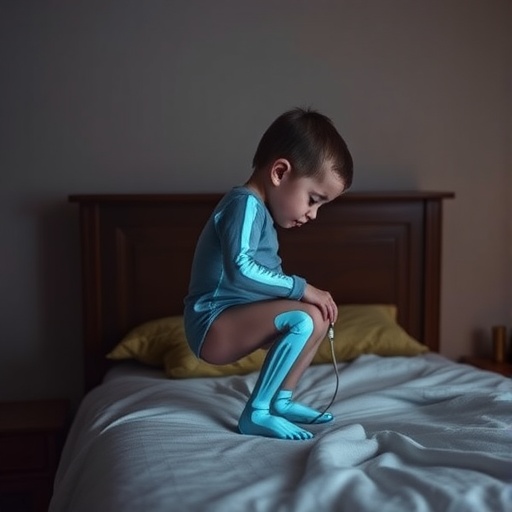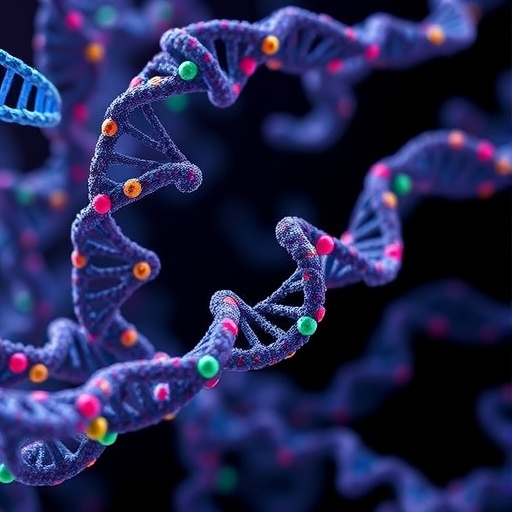In recent years, children have faced numerous health challenges, one of which has garnered attention from researchers worldwide: primary nocturnal enuresis, commonly known as bedwetting. This condition affects a significant number of children, particularly those aged 6 to 13 years, prompting investigations into its underlying causes. A new study published in BMC Pediatrics seeks to shed light on the relationship between joint hypermobility and primary nocturnal enuresis, revealing insights that could reshape our understanding of this often-stigmatized condition.
Primary nocturnal enuresis is typically viewed as a developmental phase, but its persistence can lead to anxiety and stigma for affected children. As families search for explanations and potential solutions, the research community is increasingly interested in unraveling the complexities of this condition. The research led by Derakhshan and colleagues examines the biological and physiological factors associated with nocturnal enuresis in children while exploring the less-discussed aspect of joint hypermobility.
Joint hypermobility, characterized by a wider range of motion in joints than is considered typical, can manifest in various ways among children. Some exhibit no symptoms, while others may experience discomfort or related health issues. Researchers have begun to investigate a potential link between this condition and nocturnal enuresis. The aim is to determine whether children who are hypermobile experience a higher prevalence of bedwetting compared to their peers.
The methodology employed by Derakhshan and colleagues includes a cross-sectional study design, which allows for a snapshot of data collection at a particular point in time. This design is instrumental in understanding potential correlations without implying causation directly. The researchers gathered data from a representative cohort of children aged six to thirteen, employing both parent-reported questionnaires and clinical assessments to gather comprehensive insights into each child’s condition.
Findings from the study illuminate crucial connections between joint hypermobility and bedwetting among young children. According to the data collected, children identified as having joint hypermobility exhibited a statistically significant higher prevalence of primary nocturnal enuresis. These results prompt further exploration into the underlying mechanisms that may link these two conditions.
One hypothesis proposed by researchers is that children with joint hypermobility may experience a variety of physiological factors that could contribute to nocturnal enuresis. These factors may include urinary system abnormalities, changes in bladder function, or even alterations in the autonomic nervous system, which regulates bladder control. By understanding these physiological parameters better, healthcare professionals can provide more targeted interventions for children suffering from these overlapping issues.
Throughout the research process, the study’s findings have sparked discussions within the children’s health community regarding the importance of screening for joint hypermobility in pediatric patients with nocturnal enuresis. Identifying children at risk could lead to more effective management strategies and could alleviate the emotional and psychological burden of bedwetting. Early detection may enable parents and caregivers to seek appropriate medical advice, helping to foster proactive support systems for their children.
However, it is essential to approach the interpretation of these results with caution. Establishing a direct causal relationship between joint hypermobility and nocturnal enuresis requires further investigation. Although the research has laid a substantial groundwork, longitudinal studies will be necessary to monitor the children’s development over time, ensuring a more nuanced understanding of how these two conditions interact.
In terms of therapeutic responses, healthcare providers may begin considering joint hypermobility in the context of nocturnal enuresis management. Integrating physical therapy or tailored exercises into treatment plans could improve outcomes for children facing these challenges. Moreover, discussing the mental and emotional well-being of affected children is paramount since feelings of embarrassment and frustration can arise from bedwetting issues.
The public and professional discourse surrounding joint hypermobility and nocturnal enuresis is a testament to the evolving nature of pediatric health research today. Increased awareness and understanding of these conditions are essential not just for healthcare providers but for educators and families alike, who may play a vital role in shaping children’s experiences and perceptions.
As societal attitudes toward children’s health conditions continue to evolve, it is imperative to ensure that children receive not only medical care but also emotional support. Strategies that normalize discussions around nocturnal enuresis can mitigate the stigma associated with both the condition and joint hypermobility, encouraging families to seek help without fear of embarrassment or judgment.
Research such as that presented by Derakhshan et al. is critical as it can change the landscape of pediatric medicine. By creating a better understanding of how various conditions interrelate within children, healthcare providers can offer more comprehensive and effective treatments. The goal is to foster confidence in the treatment process, facilitating a healthier environment for all children experiencing these issues.
Ultimately, awareness, education, and open dialogue about joint hypermobility and primary nocturnal enuresis will pave the way for future research and improved health outcomes. The findings from the latest study pave a promising path for further exploration that may lead to unified strategies for managing these interconnected pediatric conditions.
As we look to the future, the quest for knowledge surrounding childhood health continues. Studies like this one remind us of the complexities of individual health conditions and the interactions between various physiological traits. By continuing to explore these relationships, researchers can provide invaluable insights that will benefit not only practitioners but families dealing with the realities of nocturnal enuresis and joint hypermobility. The future of pediatric health may well hinge on the questions raised today and the research driven by those inquisitive minds willing to navigate uncharted territories.
Subject of Research: Association between joint hypermobility and primary nocturnal enuresis in children
Article Title: Association between joint hypermobility and primary nocturnal enuresis: a cross-sectional study in children aged 6–13 years.
Article References:
Derakhshan, D., Ghotbabadi, S.H., Mazarei, F. et al. Association between joint hypermobility and primary nocturnal enuresis: a cross-sectional study in children aged 6–13 years.
BMC Pediatr 25, 756 (2025). https://doi.org/10.1186/s12887-025-06175-6
Image Credits: AI Generated
DOI: 10.1186/s12887-025-06175-6
Keywords: primary nocturnal enuresis, joint hypermobility, pediatric health, children’s health, urinary system abnormalities, emotional support, pediatric research.
Tags: anxiety and stigma in bedwettingbedwetting and joint issuesbiological factors of nocturnal enuresisdevelopmental phases of bedwettingimpact of joint hypermobility on healthjoint hypermobility in childrenlinks between joint conditions and bedwettingnocturnal enuresis treatment optionspediatric health challengesprimary nocturnal enuresis causesresearch on sleep disorders in childrenunderstanding pediatric joint hypermobility





